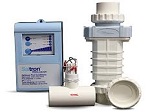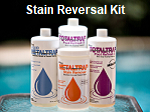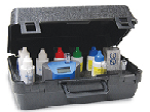|
 |
Shipping is FREE* . . . within
the Continental U.S.
A $9.99
handling charge will apply
to Continental U.S. Orders,
under $75.00. Orders
outside of the Continental
U.S. may require some
additional charge, based on
quantity and destination.
Most products can be
shipped World-Wide. International
and orders outside of
Continental U.S. - see
comments on the ordering
pages. |
|
 |

Major
Credit Cards and PayPal are accepted. |
|
On-line
shopping since 2002 - Safe and Secure!!! |
|
Filtration
problems require the right kind of
products and conditions. |
|
A
lot of variables affect filter
performance and the results show up in
the clarity and quality of the pool
water. Filters require reasonable
maintenance and cleaning, on a seasonal
or as-needed basis. If you have a
cartridge filter,
The Blaster Automatic Filter Cartridge
Cleaner will make that chore
much easier. Fine particles can
pass through many filters. A
Magnetic
Water Conditioner can help
alleviate scale formation, which can
interfere with filter performance and
efficiency.
Some water sources contain heavy metals,
which can lead to discoloration and
staining problems. Attaching a
MetalTrap Filter, to the garden
hose, will remove dissolved heavy
metals, avoiding some potential staining
problems. |
|
Automatic Filter Cartridge
Cleaner |
Hardness and Scale Control
Products |
Removes Heavy Metals, from
the water |
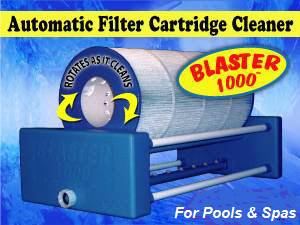 |
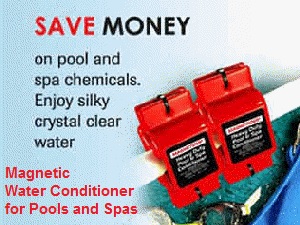 |
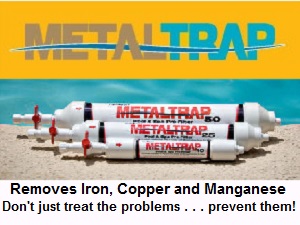 |
|
Product and Ordering Information |
Product
and Ordering Information |
Product
and Ordering Information |
If you have a pool or spa water
testing need, we should have the
product.
►
Scroll down to read through some
Question & Answer information.
◄ |
|
Water
chemistry plays a big role, in preventing algae growth,
keeping chemicals in solution and avoiding scale
formation.
A
ColorQ 2X is a 2nd generation,
Bluetooth, Waterproof, all-digital tester,
that can
measure all the common test factors. There is a model, for every sanitizing
need. Debris
blowing into the pool only adds to the
work of the filter and, if it sinks, can
cause staining. A
Salt Chlorine
Generator iks a better way to utilize chlorine
and can be used in all types of pools and with all types
of filters. Better
Circulation can be achieved, by simply
replacing the existing return jet
fittings.
The Circulator will dramatically
improve circulation, by creating a
spiraling return flow, that reaches
throughout the pool. |
|
ColorQ All-Digital Water Testers |
Salt Chlorine Generators - 3 models |
Circulation Boosting Return Jet
Fittings |
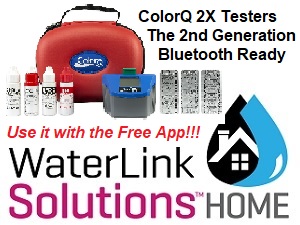 |
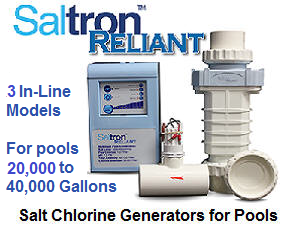 |
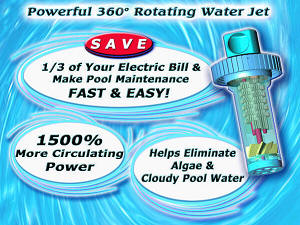 |
|
Product and Ordering Information |
Product and Ordering Information |
Product and Ordering Information |
|
If you have a pool or spa water
testing need, we should have the
product.
►
Scroll down to read through some
Question & Answer information.
◄
|
|
How to solve
pool filter problems and improve efficiency? |
Pool filter
problems are actually mechanical in nature, but
manifest themselves in ways that can make them
appear to be chemical problems. An inefficient
or ineffective filter can lead to cloudy, hazy,
dull pool water - just like a chemical
problem!!! Inadequate filter cycles can add to
difficulties in controlling algae. Ultimately,
it should be the filter that removes particles
from the pool water. Chemicals can decompose or
destroy byproducts, dead algae and debris, but
it is the pool filter that may have to remove
them. Some chemicals can help make pool filters
more efficient. Some filter systems are more
efficient than others and help the chemicals
work better. Crystal clear water and optimum
swimming pool water quality are not possible
without the meshing of pool filtration and
chemical treatment. Clarifiers may be able to
help some filters perform better, but are not
usually recommended, for use with D.E. Filters. If you need to replace a pump,
think in terms of a 2-speed or variable speed
pump. The electrical savings are
substantial, even if you increase the hours of
running time.
The Circulator is a replacement return jet
fitting, that creates a spiraling return flow,
that reaches throughout the pool and helps
eliminate dead zones, that promote algae growth.
Better circulation helps make everything better.
If problems arise, refer to the
Pool Problems
Page, as a source of problem-solving
information, broken down into various
categories. Scroll down the page and click on the linked
keywords,
catch phrases
or images, in the archived answers below, to access additional information, on that topic or product.
 |
Join our E-Letter Mailing List.
You'll receive 1-3 E-Letters a
month, featuring helpful pool
and spa advice, new product
information and sale
announcements. All we
require is your e-mail address
and you can opt out anytime you
wish.
Your information
will never be shared or sold. |
|
▼
Helpful,
Problem-Solving Information, in a question and
answer format.
▼ |
► Should
I Upsize My Pump?
My 1.5 hp
motor died. Is there a better option? What are pros
and cons of stepping up to a 2 HP?
Hill T.,
8/23/2019
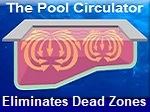
A better question would have been, should I get a 2-speed or
variable speed pump. That answer is a definite yes!!! If you
run the pump at 1/2
speed, you are using 1/8th the electricity. So even if you
double the running time, the power usage is cut in half.
That will pay for the new pump, over time. Periodically you
should run it a high speed, to help avoid dead zones. Adding
The Circulator, to replace
the existing return jets, will create a spiraling return
flow that will reach more of the pool, even at a lower
speed. Pump size is related to pool size. If the 1.5
HP pump was sized right, I don't see why you need to go to
2.0 HP. I hope that this is helpful.
Sincerely. Alan Schuster, 8/23/2019
► A
2-Speed Or Variable Speed Pump Will Reduce Costs?
How does a 2-speed or variable speed pump save money?
My electrical costs are high, due to the rates charged, and
a savings would be of interest. Thank you.
Andy G.,
Babylon, NY 6/14/2020
There is real money to be
saved. Enough to recoup the investment. This may
sound counter-intuitive, but this is how the physics work.
Let's assume, you run the pump, for 8 hours a day and switch
to half speed, for same number of hours. It w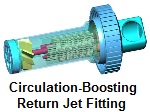 ould
seem logical, that you would cut the costs in half, but that
is not the case. You would reduce power usage, by 2 to
the third power, and
power usage would drop
to 1/8. If you reduce the speed, for the same 8 hours
by 2/3, the savings will be 3 to the third power and
electrical usage would drop to 1/27. If you
compensate, for the weaker return flow, by running the pump
24/7, the cost at 1/2 speed would be 3/8 of what it was at
full speed. At 1/3 speed, and operating 24/7, the
electrical costs would be 1/9, as compared to 8 hours, at
full speed. I agree that this may seem to good to be
true, that that is how the physics determine the electrical
usage. On the negative side, flow to some areas of the
pool may be weaker and create a dead zone. You could
add The Pool Circulator, to each
return jet and create a spiraling return flow, which will
improve circulation, to all areas of the pool. This
can be very helpful, especially when operating on low speed. You
also have the option of running at full speed, a periodic
basis. There's another plus. At reduced speeds,
the flow through the filter is decreased and that increases
the efficiency of the filter. The source of this
information were articles written in industry trade
publications. I hope
that this suggestion works out for you.
ould
seem logical, that you would cut the costs in half, but that
is not the case. You would reduce power usage, by 2 to
the third power, and
power usage would drop
to 1/8. If you reduce the speed, for the same 8 hours
by 2/3, the savings will be 3 to the third power and
electrical usage would drop to 1/27. If you
compensate, for the weaker return flow, by running the pump
24/7, the cost at 1/2 speed would be 3/8 of what it was at
full speed. At 1/3 speed, and operating 24/7, the
electrical costs would be 1/9, as compared to 8 hours, at
full speed. I agree that this may seem to good to be
true, that that is how the physics determine the electrical
usage. On the negative side, flow to some areas of the
pool may be weaker and create a dead zone. You could
add The Pool Circulator, to each
return jet and create a spiraling return flow, which will
improve circulation, to all areas of the pool. This
can be very helpful, especially when operating on low speed. You
also have the option of running at full speed, a periodic
basis. There's another plus. At reduced speeds,
the flow through the filter is decreased and that increases
the efficiency of the filter. The source of this
information were articles written in industry trade
publications. I hope
that this suggestion works out for you.
Sincerely. Alan
Schuster, 6/14/2020
► Cartridge
Filter Uncertainty?
I have an
in-ground pool (approx. 15-18K gallons) with a new cartridge
filter which as installed Oct. 2015. During this summer
(2016), I noticed some air bubbles in the return jets along
with some silt, but my water level has been holding steady.
The pressure on the filter gauge has maintained at 15-17
PSI, since installation, and does not increase much, if any,
over time. Any suggestions? Thanks.
Steve S., Denton, TX, 9/29/2016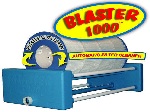
You didn't say anything about
cleaning the filter cartridge or performing any routine
maintenance. Make
sure that the pressure
is within the manufacturer's recommendations. High
pressure results in poor circulation and low pressure is a
sign of inadequate filtration. I would start by
cleaning the filter cartridge and inspecting it for any
defects. Silt should not be passing through the
filter. Cartridges do not last indefinitely, so
inspection is a must, a the first signs of a problem.
Cartridge cleaning can be made easier and more effective,
using an Automatic Filter Cartridge
Cleaner. If problems continue, you might try
replacing the existing cartridge.
Sincerely. Alan
Schuster, 9/29/2016
►
Vacation Schedule?
We have a new salt chlorine
generator for our in ground fiberglass pool. Right now the
chemicals are perfect and the pool is beautiful. But we are
going to cover it and leave for 2 months, with our neighbor
coming to check the water level once a week. We live in a
HOT desert area. Do we need to run the filter as often as we
do when we are using the pool (which is 5 hours a day) or
can we run it for a shorter period of time while we are away
and the pool is getting zero use. Thanks for your time. I
have read a lot of the questions and answers and it seems
like you would be the one to ask. Thanks.
Russ W., 5/18/2018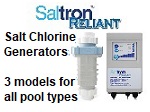
Five hours a day is not all
that much time, especially in hot, sunny locations. I would
not reduce the time. If your
salt
chlorine generator is in-line, you certainly need the
pump running time maintained, at a level high enough to meet
the pool's chlorine needs. An
auto-filler will solve the
water level product. However, all things considered, it
might pay to have a pool service look after the pool.
It could help protect your investment. I hope that the information
provided was helpful.
Sincerely. Alan Schuster, 5/18/2018
►
Single Speed, Two-Speed
Or Variable Speed Pump?
My question
concerns which type motor to use on the filter system for
cost savings. I operate my pool different from most pools. I
use an ionizer system I installed several years ago. My
difference, I never close my pool for winter. This saves me
close down and start up chemicals, but I do add some liquid
chlorine every week. I cover the pool with a net to keep out
leaves. I run my filter every day during the year but do
vary some days in winter when algae should not be a problem.
Which type motor should I use, single stage, double stage,
or variable speed motor for cost savings? The ionizer has
paid for its installation in chemical savings and I question
if a more expensive motor would pay for itself in operating
cost. Enjoy your Web Site and always look for any thing I
need from your site.
Richard,
4/19/2016

Either way, 2-speed or variable speed will afford you big
savings on electricity. If you operate it at half speed, for
twice as long, you can save 75%
on the cost of electricity. The only down side is that the
return flow will be weaker and some dead zones may develop,
as a result of the diminished strength of the return flow.
Adding The Pool Circulator
should help make a dramatic difference, by creating a spiraling
return flow. This better eliminates dead zones and
improves chemical distribution. I hope that the
information provided was helpful.
Sincerely. Alan Schuster, 4/19/2016
►
How To Replace Filter
Sand?
We just bought
a pool, with a pool, and we are new to pool ownership.
I understand the sand has to be periodically replaced
and I prefer to start with a clean slate. How do I
replace the sand? Thank you.
Frank N., 6/2/2014
The filter system should be
turned completely off. Rotate the control head
to the closed position. Close all ball valves, if present,
to minimize the water loss. Remove the neck clamp, which
holds the control valve onto the tank. Slowly remove the
filter head, off of the stud pipe, that runs the entire
length of the filter tank. Set aside and protect, from
damage. The stud pipe should still be positioned, in the
middle of the sand filter, while all of the sand is removed.
Use a cup or a shop vacuum, to remove all of the old sand
filter.
Inspect the laterals. Most sand filters will have 6-8
laterals. Check to see, if the holes have expanded or
cracked, as this could allow the fresh sand to get back into
the pool. If there are signs of damage, consider
replacing all the laterals, at one time, to help avoid
performance issues. Make sure that the bottom-most
lateral remains attached, to the stand pipe. If
unattached, you might require a new stand pipe.
Use only filter grade sand or sand replacement filter media.
When ready to add the fresh sand, cap off the top of the
stud pipe, to make sure that sand does not get down into the
middle of the pipe. Allowing sand to get into the
middle of the pipe, will allow cause sand to get into the
pool, when filter operation is resumed. Use the sand cap
grate that was supplied, with your filter. If you no longer
have the piece, use a suitably-sized plastic cup, to close
off the center pipe. Distribute the new sand evenly,
around the stud pipe and outside of the tank. Try to
evenly coat the bottom of the filter. Add only the
exact amount of sand, that your filter requires. Do
not over-fill or under-fill the sand filter, as this could cause
improper filter performance. Make note of how much
sand is required, for future reference. Reassemble the
filter and turn on the pump.

Above ground sand filters typically hold between 100-200
pounds of sand. each. Inground sand filters typically
contain between 325-900 pounds of
sand. Filters vary according to model and
manufacturer, so make sure you are of the correct amount
of sand, that is required, for proper performance.
Sand is typically replaced every 3-5 years, but will vary,
based on seasonal usage and other factors.
Zeolites are a sand
replacement media, that provides improved filter
performance. The correct amount of zeolite is
typically
1/2 of the normal weight of filter sand. The downside
of zeolite is that it has to be regenerated, using salt
solution, possible a few times year. However, if you
are using a Salt
Chlorine Generator, regeneration is avoided, because of
the salt content, in the pool water.
I hope that this information
is helpful.
Sincerely. Alan
Schuster, 6/2/2014
► Diatomaceous Earth
(DE) Or Sand?
Are earth (DE) filters as good or
better than sand filters?
Bill M., Columbus, OH, 8/31/2012
There is general consensus that DE Filters are capable of
removing smaller particles than sand filters. This usually
translates into better water quality and fewer water clarity
problems. However, there are other considerations to
consider, in choosing a filter. You might want to consult
with a local pool professional about the best choice for
your area. The efficiency of a sand filter can be improved
by substituting a zeolite sand filter replacement media
for the filter sand. It will remove particles, as small as a
few microns, which is far better than ordinary sand filters
and most other types, as well. This product is modestly
priced, lighter in weight and longer lasting. I hope that I
have been helpful.
Sincerely, Alan Schuster, 8/31/2012
► How Often
To Replace The Sand?
I have some questions about replacing
the sand in our pool filter. We purchased the pool in July
of last year so it has been in use for 1 and 1/2 summer
seasons. The pool is an above ground pool, 52 inches deep,
and 18' round. We have not had any filtering problems but I
thought that I read somewhere that the sand should have been
replaced after the first season of use. Should I replace the
sand in the filter before I use it for the summer of next
year or is it okay
to use the same sand again this year? Under normal operating
conditions, how often should the sand in the filter be
replaced? Thanks for your response.
The Grays, 6/7/2009
Simple enough question! But no simple answer! This is a very
subjective area. Ask multiple people and you'll get multiple
answers. Unless the filter manufacturer, instructs to the
contrary, I don't see the need to replace the sand every
year or two. Much will depend upon the filter and pool
conditions. If things are working properly, I am inclined to
go as long as 3-5 years. Consider that the pool is in
operation for only part of the year. If there are problems
with the pressure readings, loss water clarity or any signs
of channeling, I would consider replacing the sand. Always
use a filter grade sand or a zeolite sand filter
replacement media. Zeolites can be used as a sand
replacement and will produce much better results, reduce
filter cycles, save on chemicals and the frequency of
backwashing. A modestly dirty sand filter actually works
better than a clean one and it is a mistake to backwash or
replace sand with too great a frequency. I hope that I have
been helpful. Enjoy the season.
Sincerely. Alan Schuster, 6/7/2009
► Zeolite Use
With A Salt Chlorinator?
I have a salt water chlorination
system with a sand filter. I am investigating the
possibility of using Zeolite, instead of ordinary filter
sand. Are there any issues that I should be aware of? Would
the zeolites still need to be recharged with a more
concentrated salt water solution periodically, since there
shouldn't be any issues with chloramines? Regards.
Terry T., Austin, TX, 6/2/2012
Good question! Pools with
salt chlorinators work extremely
well with zeolites: a sand filter replacement media.
In a standard, chemically chlorinated pool, zeolites will
attract combined chlorines and hold them to the media. In
order to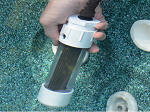 release the combined chlorine, an eight to ten
percent sodium chloride solution is used to reverse the
adherence of the combined chlorine, restoring and improving
the filtering performance. A follow up shock treatment will
probably be required to get the combined chlorine level to
under 1 PPM. Chloramines collecting on the surface of the
Zeolite should not be an issue, with the salt chlorinating
systems, since the pool water will already have around 3,000
ppm of salt content. This negates the need to regenerate the
zeolite, with a high sodium chloride solution. The
effectiveness of the chlorine, produced by the salt
generator, should destroy any ammonia-based by products or
chloramines, that are introduced into the pool, at normal,
typical levels. All of the water, passing through the salt
chlorinator, will be free of ammonia-based byproducts and
chloramines, when the salt chlorinator is working, within its
limits. Use a filter bed cleaner, at the end of the
swimming season, to remove any mineral scale, oils, scum or
organic matter that may cling to the media. These two
products work well together to produce better water quality
and better chlorination. Enjoy the season.
release the combined chlorine, an eight to ten
percent sodium chloride solution is used to reverse the
adherence of the combined chlorine, restoring and improving
the filtering performance. A follow up shock treatment will
probably be required to get the combined chlorine level to
under 1 PPM. Chloramines collecting on the surface of the
Zeolite should not be an issue, with the salt chlorinating
systems, since the pool water will already have around 3,000
ppm of salt content. This negates the need to regenerate the
zeolite, with a high sodium chloride solution. The
effectiveness of the chlorine, produced by the salt
generator, should destroy any ammonia-based by products or
chloramines, that are introduced into the pool, at normal,
typical levels. All of the water, passing through the salt
chlorinator, will be free of ammonia-based byproducts and
chloramines, when the salt chlorinator is working, within its
limits. Use a filter bed cleaner, at the end of the
swimming season, to remove any mineral scale, oils, scum or
organic matter that may cling to the media. These two
products work well together to produce better water quality
and better chlorination. Enjoy the season.
Sincerely. Alan Schuster, 6/3/2012
► High
Cartridge Filter Pressure?
I got an inground pool last year. A
few weeks ago, I started my pump and began adding chemicals.
My pump is running at the max pressure 30 lb. I was told
that the pressure should only run between 15-20 lbs
pressure. It is a cartridge filter. What do I need to do to
get the pressure down?
Stacy J., 4/5/2005
Your pressure is probably too high because of all the
debris, dead algae, etc., that has been removed. It simply
needs some routine servicing. You have a cartridge filter
and you need to remove it and thoroughly clean it with a
garden hose. This procedure should be performed on a
periodic basis, usually every week or two. There is an easy
way to clean cartridge filters, that you might look into.
The BLASTER Automatic Filter Cartridge Cleaner
uses a simple garden hose connection and there's nothing to
install. I hope that I have
cleared things up and gotten on the way to better water
quality.
Sincerely. Alan Schuster, 4/5/2005
► Cleaning A
Cartridge Filter?
We just had a new pool installed and
it has a cartridge filter. How often should it be cleaned
and how? Thanks.
Mike M., 6/24/2009
There is no set rule and it will vary with the season.
Usually, every 1-2 weeks or when the pressure rises to the
point where the water flow has diminished. Use a garden hose
and spray the cartridge from the top down and it is being
rotated on one end. Simple enough, but a little on the wet
side. Depending on water chemistry the cartridge should be
soaked in diluted acid or chlorine solution, according to
the manufacturer's instruction. If you would like to clean
the filter cartridge better and with less effort, the
Blaster Automatic Filter Cartridge Cleaner is the right
product. I hope this information will help. Enjoy the pool.
Sincerely. Alan Schuster, 6/25/2009
► How Much
Zeolite Is Required?
If a pool filter system takes 6 bags
of sand (300 pounds), how much zeolite does it require? What
size packages are available? Is more better? My filter is
3.0 cubic feet. Will adding more zeolite better improve
the performance? Thank You.
Richard B., 1/10/2005
You should require one-half of the weight of sand, given the
fact that zeolite is much lighter than sand. Zeolite
is conveniently is typically packaged in 25 and 50-pound bags. More is
not better. Just impractical! Each 50 pound bag of
zeolite is approximately 1 cubic foot. This makes the
calculation very easy. In your case, you require 150 pounds
or 3 cubic feet, which comes out to 3 of the 50-pound bags.
Clearly, the water quality will be greatly improved, by
simply adding the recommended amount of zeolite. Have a
good season.
Sincerely. Alan Schuster, 1/10/2005
► Filter
Cleaning With Zeolite Media?
I know that zeolite has to be
regenerated with a salt solution at least once a season, but
does it also have to be cleaned? Thanks.
Ron C., Texas, 6/20/2008
A leading manufacturer of zeolites recommends cleaning the
media with a soaking filter cleaner that removes scale and
organic oil build-up at least once per year, as a good
maintenance practice. This is addition to the regeneration
with a salt solution, that should be done at least once a
year. Other situations that would warrant cleaning the media
would be after plaster dust is removed on a new in-ground
gunite pool and in extremely high hardness conditions.
Zeolite, being somewhat of a natural water softening
mineral, will remove some calcium carbonate in high hardness
conditions. The cleaning will remove any scale build-up from
these conditions. A “Cleaning and Regeneration” product,
specifically formulated for use with zeolite filter media is
available at many pool professionals. I hope that this
information will prove helpful.
Sincerely. Alan Schuster, 6/20/2008
► Effect On
Back Pressure?
I would like to add The Circulators to
my pool. I have a solar system and I don't want to
cause the backpressure to rise. Can I add The Circulator, to
each of the three returns. Thanks for the chance to ask
questions.

Frank M., Bonita Springs, FL., 3/13/2008
The Pool Circulator will not increase the backpressure to any
great extent, as determined by a leading pump/filter
manufacturer. Adding The Circulator Circulation Booster, to
each of your returns (3) will help get the most out of your
Solar Heating System, assure better distribution of
chemicals and eliminate the dead zones that promote algae
growth. I hope that you'll find the information helpful.
Sincerely. Alan Schuster/ 3/13/2008
► Zeolite
Media and Salt Chlorinators?
I have an in ground pool (76,000
Liters) with a salt water chlorinator and a gas fired
heater. I have been reading your site and using your
knowledge for some time now. I am interested in a couple of
issues. The first is the discussion around “cleaning” the
sand in my filter. I have struggled with cloudy water this
summer which seems to be a result of the wet weather we have
had. It seems that every time we get a good rain fall my
pool goes cloudy and develops and algae problem. My water
chemistry has been good. I will be closing the pool in a
month or so and I might as well use the heater! and I am
interested in knowing more about the need to “clean” the
sand in the filter due to the problems I have been seeing
this summer. Why is this done? When is the best performed?
Is it something that should be done on a regular basis and
if so how often? My second issue is the filter media itself.
What are the benefits of me switching my media from sand to
Zeolite? Does the salt water system I have make this type
of media more beneficial or are we simply comparing apples
to apples? If it was beneficial when the best time is to
make this change, when I close the pool or when I open it in
spring? As always. Thanks for the help.
Mark H., Toronto, Ontario, 9/13/2006
Zeolite sand filter replacement media can help you
remove those small particles that might, otherwise, pass
right through a sand filter. The fact that you have a
salt
chlorine generator, makes it even easier. You will never
have to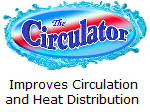 regenerate the Zeolite, because of the salt in the
water. Zeolite will allow you to go longer between
backwashes and produce better quality water. Occasionally,
the Zeolite filter media will need to be cleaned, like any
sand filter: once a season should be more than adequate for
a pool like yours. I suggest that you test the water for
free chlorine and determine that a level of 1-3 PPM is being
maintained. Test the salt level, to make sure that it is in
the proper range. Your cloudy water and algae problems
may more related to the free chlorine level and not totally
related to the filter performance. Areas of poor circulation
create dead zones that promote algae growth, even when the
water tests out well. Better circulation assures better
distribution of the sanitizing chemicals and makes algae
problems less likely. The Pool Circulator is an easy-to-install
device that will dramatically improve circulation and
eliminate any dead zones. I hope that I have been helpful.
regenerate the Zeolite, because of the salt in the
water. Zeolite will allow you to go longer between
backwashes and produce better quality water. Occasionally,
the Zeolite filter media will need to be cleaned, like any
sand filter: once a season should be more than adequate for
a pool like yours. I suggest that you test the water for
free chlorine and determine that a level of 1-3 PPM is being
maintained. Test the salt level, to make sure that it is in
the proper range. Your cloudy water and algae problems
may more related to the free chlorine level and not totally
related to the filter performance. Areas of poor circulation
create dead zones that promote algae growth, even when the
water tests out well. Better circulation assures better
distribution of the sanitizing chemicals and makes algae
problems less likely. The Pool Circulator is an easy-to-install
device that will dramatically improve circulation and
eliminate any dead zones. I hope that I have been helpful.
Sincerely. Alan Schuster, 9/13/2006
►
Regenerating Zeolite Filter Media?
Thanks for all the great info on your
site! We just replaced our sand in our filter with zeolite
media. The immediate improvement in water clarity was
amazing! I am wondering if there is anything we need to do
different with pool care, chemicals, etc now that we are
using this. Each spring when we open our pool, we use a
super floc. (we have a mesh security cover). Will we still
be able to use this or would that not be advisable now with
the zeolite. Just asking to be prepared for next year. Also
should we still be using a clarifier weekly, as we have been
for the past several years. We have read that the zeolite
needs to be regenerated with salt water solution. How often
is that necessary? Thanks again for the service you provide.
Annette, 6/16/2010
You should find less need to use clarifiers because of the
improved filtration. If it necessary to regenerate the
Zeolite at least once a season, in outdoor,
residential pools. Zeolite helps remove chloramines
from the pool water and regeneration restores the ability of
the filter media to perform this important function.
Individual pool circumstances can vary greatly and
regeneration should be considered, whenever shock treatment
to control the combined chlorine level becomes more
frequent. Regenerate as follows:
1. Drain the existing water from the filter, then close the
inlet and outlet valves.
2. Mix the salt solution, 3 pounds of salt in five gallons
of water, in a plastic container.

3. Open the filter vessel and pour the salt solution to
completely cover the zeolite filter media.
4. Allow the salt solution to stand in the media bed for a
minimum of four hours.
5. Backwash the salt solution out the discharge drain with a
backwash cycle.
6. Resume normal filtration of the pool water.
If you have ever given thought about getting a
salt chlorine
generator, you might be interested to know that it will
totally eliminate the need to regenerate the zeolite media.
I hope that the information will prove helpful.
Sincerely. Alan Schuster, 6/16/2010
► Sand Vs.
Zeolite: operating costs?
Thanks for all the advice on the web
site. I have a small above ground pool (18' x 4') and I am
using the biguanide chemicals. I have a sand filter that has
been great but now in it's third season I am finding I need
to run the pump about 3 times longer than last year to avoid
cloudy water. I am very tempted to switch to the zeolite,
but I was wondering, all other things equal, if it will
require more electricity to operate per gallon filtered than
the sand? My intuition tells me that if the filter works
better, the pressure will be higher and the flow rate will
be lower (for a given pump), thus requiring more time to
filter the entire pool. Is this true? Has anyone ever
compared the cost of electricity of sand vs. zeolite?
Kevin W., 7/8/2004
I don't know if studies have been done on operating costs,
but I would hazard a guess that you will get better water
quality with less filter time using
zeolite. Sand filters
can be very inefficient in removing fine particles. With
zeolite you will have effectiveness that is
comparable to a DE filter,. without a lot of the DE
problems. There will less need to run the filter for
extended periods of time to clear up the water. You should
be able to run the filter on a more predictable cycle, so
long as proper water sanitation is maintained. I hope
that I have cleared things up a bit. Enjoy the season.
Sincerely. Alan Schuster, 7/8/2004
► Still
Cloudy?
Hi Alan, first of all, thanks for
spending the time to perform this service. Many of your
responses to others have already helped us. We are new pool
owners: came with the house. It's a 20 yr inground, 25,000
gal concrete pool. We hired a company to "open" the pool
that provides this service to others in our area. They
started by shocking and adjusting water chemistry - got rid
of the green, but cloudiness remained. Then more chlorine
shock ~ 5 days later. Another 4 days, and it's still cloudy.
I noticed the pressure reading on the new instrument was ~
25 over this entire period, and never really changed that
much (even after backwashing) - but outflow back into the
pool always decreased with time, suggesting something was
retained by the filter. Next, they tried a quart of that
clarifying agent you recommend, which improved the
cloudiness somewhat You could see the bottom of the shallow
end. After 2 more days ~ 1 lb of DE powder was added to the
skimmer, which plugged the filter, so we had to backwash
out. At this point, I suggested we investigate the filter.
It's not new, and the fact the pressure doesn't change
suggested channeling to me; but they wanted to trying
shocking 1 more time, so we did so today. By the way, water
chemistry was fine, except for today, we had to acidify to
get back within the normal range. We also have been
backwashing 2x daily. Alan, what is your diagnosis and
recommendation? Thanks much.
J. and C., Dayton, OH, 6/4/2010
From your letter, it is safe to assume that you have a sand
filter and it is very possible that channeling is part of
the cloudy pool water problem. A defective pressure gauge is
another possibility. If you have a sand filter, an excellent
way to greatly improve
filtration is to replace the sand with a zeolite sand
replacement filter media. You mentioned that you added
several doses of shock, but did not state any chlorine
readings. If you are unable to maintain a Free Chlorine
reading for a reasonable period of time, it could be that
there is still algae and debris in the pool. This will
consume the chlorine and cause a continuing clarity problem.
The key to your problem is to maintain a stable chlorine
reading of 1-3 PPM for an overnight period and maintain a
properly working filtration system. The high pH reduced the
effectiveness of the chlorine, decreased the solubility of
calcium minerals and may have contributed to the problem.
You could use an algaecide, follow the label--more is not
necessarily better. I hope that
I have been helpful. Good luck.
Sincerely. Alan Schuster, 6/4/2010
► Rapidly
Rising Filter Pressure?
We have a 20'x40' inground pool, 1-1/2
hp pump and a D.E. filter. We have fantastic water pressure
immediately after bumping or flushing the filter, but the
pressure builds quickly and soon the water pressure slows
way down, usually within 15-30 minutes. We are starting this
season with poor water quality and we really need constant
circulation to get it cleared up, but the pressure builds so
quickly that the filter is not doing any good. The high
pressures have also caused water to seep around the seal of
the filter. I've cleaned the filter thoroughly and added
D.E., nothing seems to help. The filter is plumbed according
to the manufacturer's specs, but there is no filter bypass.
Should I add one? Should we switch to a sand filter? This
thing is just too restrictive to do any good. HELP!
Shelly and Tia, 4/12/2009
It seems apparent that your problem is due to the clogging
of the filter. The poor water quality is causing debris and
algae to slowly reduce the water flow, raising the pressure.
If you are using biguanide, it may be part of the problem
and will require an alternate treatment. If you are using a
clarifier or a quat algaecide (dimethyl benzyl ammonium
chloride or similar) stop the use, at least temporarily. Add
shock to the pool to boost the Free Chlorine reading to 5-10
PPM and keep it there. Retest the water every few hours and
add more product, as needed. Keep the pH at 7.2-7.6. Bump
the filter and, if after the Free Chlorine level has be
elevated, the problem continues, you should consider
cleaning the filter and replacing the DE. A DE filter can
produce excellent water quality, but can be overwhelmed by
too much material in the water. That's where I think you
are. The chlorine will change all that. If you are using
biguanide, get back to me. I hope that the information will
prove helpful.
Sincerely. Alan Schuster, 4/12/2009
► Dirt In The
Corners?
I have a few spots, that seem to
collect dirt and debris. I guess it follows the natural
water flow in the pool. I use a Robotic Pool Cleaner every
other day and while it does a great job, there is dirt
accumulating in a few spots. Any suggestions.

John. L. Clearwater, FL, 5/26/2005
A Robotic Pool Cleaner
usually does a great job. Nonetheless, new debris will
settle in areas, based on the flow patterns.
The Pool Circulator is a circulation boosting device that
can be easily installed in each return and it will
dramatically improve the circulation, by as much as 1500%.
This should help prevent dirt from accumulating in any
particular spots. And as a bonus, you'll get better chemical
distribution and be less likely to have chemical dead spots. I hope
that this information will prove helpful.
Sincerely. Alan Schuster, 5/26/2005
► Replacing
Sand?
We have an inground pool and after
shocking and putting in other chemicals needed to get the
pool ready for summer, the water is a beautiful color, but
we cannot see the bottom of the pool. We've taken in 3 water
samples to our pool supply store and they have suggested
that we might need to change the sand in our filter. How
expensive is this and is it easy to do ourselves or would we
be better off hiring someone? How much does the sand cost
and where do you buy it?
Bobby L., 5/15/2009
Sand should be replaced every 3-5 years. Cost is modest and
only certain types of sand is suitable. Pool dealers should
carry the right kind. Even better than sand would be using a
zeolite sand filter replacement media. Zeolites are modestly priced, weighs 1/2 as much as sand and produces
much better water quality. Sand filters can become channeled
and lose their efficiency. There is some work involved. The
sand has to be removed and the filter cleaned and inspected.
Most pool owners do it themselves. Some points to remember!
Backwashing too often is a common mistake. Generally, the
filter should be backwashed only when the pressure is too
high. With zeolites, you will get better results,
using fewer chemicals and shorter filter cycles. I hope that
this information will be helpful.
Sincerely. Alan Schuster, 5/15/2009
►
Zeolite's Effect On
Hardness?
Reading through a California
Contractors study guide I came across a statement in their
glossary regarding Zeolite. In it they state: " Zeolite
filter: Filter used to soften water. Filter medium is
zeolite, a substance which will remove calcium and magnesium
from water, replacing them with sodium. Does not remove
suspended matter from water." I live in an area that has
very soft water, with little or no calcium, we experience
very aggressive water conditions. We add Calcium Chloride to
our water on a regular basis. The question that concerns me
is, does Zeolite remove calcium and manganese from the
water? I have been using Zeolite exclusively for all my
commercial sand filter installations for years. I use it on
heavily abused resort spas in conjunction with ozone,
bromine and ORP controls. The media backwashes easily and
the water is clear all the time. My clients have reduced
their water consumption, especially their draining and
refilling by an easy 75%. The savings in heating a freshly
filled spa is enormous. It's a great product and worth the
extra expense. I am concerned about the Calcium statement!
Stan Z., Mammoth Lakes CA, 12/27/2016
This statement refers to a manmade zeolite that has been
modified to be used with water softeners.
Zeolite is
a natural mineral and can be used in pools and spas with
hardness, in the normal ranges, without any problem. If the
hardness is above 400 PPM, zeolite may lower the levels and
that would be of benefit to the overall water chemistry. I
hope that this has cleared up the mystery.
Sincerely. Alan Schuster, 12/27/2016
► Channeling
Causes?
Last fall, after weeks of struggling
with cloudy water, I saw your website and concluded that the
sand in my filter was probably channeled. I replaced the
sand with a zeolite filter media. Since then all has been sparkly. What
causes channeling? Is it possible that zeolite could also
become channeled? How does one prevent channeling? Once it
has happened, is replacing the filter media the only
solution? Thanks for your help!
Niki P., 7/30/2012
There are a couple of situations where channeling can occur
in zeolite. The most common occurrence happens when
mineral scale builds-up in the media. This can occur when
dealing with a high mineral water source, such as well
water. It can also occur when calcium hardness
is allowed to run too high. Since Zeolite is a natural water softening
media to some degree, it can remove and bond calcium
carbonate when concentrations are high. It is suggested to
keep calcium hardness below 250ppm in pool water. A common
mistake that some pool builders make after plastering a
gunite pool is to allow the plaster dust to build-up in the
filter without cleaning the media. Plaster dust contains a
high concentration of calcium carbonate. The combination of
the two can create a hard layer of media and result in
channeling. The media should be cleaned with an acid based
sand filter cleaner or a muriatic acid solution, after the
first couple of week’s operation to correct this problem.
Another situation where channeling can occur is with the use
of biguanide. This material can cause sand, zeolite and D.E.
filter media to coagulate. It can not be backwashed from the
filter and can result in diminished efficiency. Some of the
biguanide manufacturers suggest monthly cleaning of the
media, when used with this chemical. I hope that the
information proves helpful.
Sincerely. Alan Schuster, 7/31/2012
► Scaling And
Cloudy Water?
My pool is located in a very hard
water area and I have some scaling and cloudiness issues.
The pool maintenance company has mentioned something called
a magnetic conditioner. What is this?
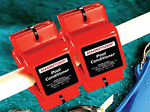
Roy N., Chandler, AZ, 6/2/2005
Magnetic water conditioners
contain strong permanent magnets,
that are strapped on the return lines. Pool water passing through the return lines is subjected to
a magnetic field, causing micro-changes in some of the water
content. In short, the magnets are said to cause some
beneficial changes: reduction and elimination of calcium
scale, improvement in sanitizer efficiency and some positive
effects on the overall water chemistry, clarity and
filtration. In very hard water situations, this type of
product can make a substantial improve in the water quality.
No power is required and installation should be a simple. I
hope that I have been of assistance.
Sincerely. Alan Schuster, 6/2/2005
► Lack Of
Filter Efficiency?
I emailed you a few weeks back about
cloudy pool water (despite good water levels) and you told
me to add DE to my sand filter and I must say it worked like
a charm. I now know I was backwashing too frequently, which
no one told me before. Recently, I had a HORRIBLE algae
attack (I’m guessing due to a vacation) which made my pool
the prettiest and brightest green I have ever seen! I have
since shocked the dickens out of it and it is now finally a
bright cloudy blue. This actually looks good to me since it
was so green for the last 10 days! Now I know I have to just
get rid of the cloudiness. It seems to me that if I add DE
to my sand filter it works better, but what can I do to not
have to go out at 3am and make sure the pressure is not too
high and the filter is not working at all? I fear something
is wrong with my sand filter because I used to backwash too
much. I live in Wisconsin so there is not much swim time
left but I would like to get my filtration system to the
point where not only is it working the best but I know what
to do for next season. The pool is not even a year old and
is 18 X 4. Thankful.
Julie, 9/10/2010
PS I have been told to only use sodium based chlorines as
opposed to calcium ones. Is it fair to say that I can stick
with that general rule?
Dead algae
can pass right through some sand filters. Adding an
occasional dose of a blue clarifier can help improve the
ability of t he pool filter to remove these fine particles.
Backwashing a sand filter doesn't damage the filter: it just
lowers the efficiency
by opening up the spaces
between the sand grains. Adding DE helps to reduce the
spaces and improves efficiency. Think of it as clean dirt.
Don't add so much DE that the pressure will
rise towards the upper end of the operating range.
The Pool Circulator is a
circulation boosting device that can be easily installed in
each return and it will dramatically improve the
circulation, by as much as 1500%. Improving
circulation helps bring more dirt, sediments and silt, to
the skimmer and onto the filter.
Sodium hypochlorite is popular in many areas. The only
reason not to use calcium hypochlorite would be because your
calcium hardness is already high enough or should not be
increased beyond its present level. Another effective means
of improving the water quality is with a robotic pool
cleaner. It acts as a second filter, as it vacuums the
underwater surfaces. And it will save you lots of time! I
hope that I have been helpful.
he pool filter to remove these fine particles.
Backwashing a sand filter doesn't damage the filter: it just
lowers the efficiency
by opening up the spaces
between the sand grains. Adding DE helps to reduce the
spaces and improves efficiency. Think of it as clean dirt.
Don't add so much DE that the pressure will
rise towards the upper end of the operating range.
The Pool Circulator is a
circulation boosting device that can be easily installed in
each return and it will dramatically improve the
circulation, by as much as 1500%. Improving
circulation helps bring more dirt, sediments and silt, to
the skimmer and onto the filter.
Sodium hypochlorite is popular in many areas. The only
reason not to use calcium hypochlorite would be because your
calcium hardness is already high enough or should not be
increased beyond its present level. Another effective means
of improving the water quality is with a robotic pool
cleaner. It acts as a second filter, as it vacuums the
underwater surfaces. And it will save you lots of time! I
hope that I have been helpful.
Sincerely. Alan Schuster, 9/10/2010
► No Water
Flow?
My problem is that the filter is not
pulling any water. What could be the problem? Thank You.
B. K., 11/27/2009
There could be several reasons: clogged filter, clogged pump
strainer, loss of prime, broken pump impellor, clogged line
or valve, closed valve or an air leak. Check to see that the
valve is in the correct position. Backwash the filter to
waste. Resume filtering. If the water is still not flowing,
shut off the filter and open the pump basket cover. Pour
water into the basket (clean it out first), in attempt to
manually prime the pump. If none of these things work, you
will have to check the lines, impeller and valves: the
answer is there, it is a matter of elimination. If you have
a filter operating manual, check to see if it has a
trouble-shooting guide. It might help solve the problem.
Good luck and I hope that I have been helpful.
Sincerely. Alan Schuster, 11/27/2009
► Green Water
Won't Clear Up?
Hi, Alan, your web questions and
answers are very helpful and informative. Thank you. I have
a problem with my pool water. About 2 weeks ago, my pool
water started to get green, cloudy and ugly. I realized I
had slipped and ran out of chlorine. I figured, no problem,
I'll just shock with a couple pounds of chlorine granules,
and it will clear up as it had in the past. However, it is 2
weeks later, the water is still bright green and I cannot
see the bottom. I have added at least 8 lbs of chlorine and
tried something recommended by the pool store - a chemical
that binds to chlorine to clear up/kill algae better. I have
run the filter for 12 hours here, 24 hours there, etc. Here
is some other information. The pool water is about 4 years
old without being completely flushed and re-filled--and now
it is too hot outside (I'm in Arizona) to risk cracking the
pool finish (I understand you should not empty your pool if
the temperature outside is above 80 degrees F). The pool is
about 18,000 gallons with a sand filter. In the past, a
little shock and an extra 12 hrs of filtering always cleared
up the problem. Do I need to change my sand? Is it possible
to run out of sand in the filter? I'm thinking it is a
filter problem, and not a chemical problem - my chlorine
level is off the charts on my test kit (it goes up to
10ppm), I'm guessing it is 30ppm or higher based on the
quantities of chemicals I used. Do you have any suggestions
to help? Thank you.
John U., Arizona, 5/15/2009
You told me a lot, but still not enough. If you're testing
for Free Chlorine and the level is as high as you state, it
is not likely that th e problem is still algae. Sand filters
can be subject to such problems. If the sand has not been
replaced in a long time, it might be a good place to start.
Sand filters
can become channeled and that prevents proper filtering
efficiency. If you are going to replace the sand, you might
consider using a zeolite sand
replacement filter media. This product is modestly priced,
weighs one-half as much as sand and provides much better
filtering efficiency. This will help increase the
efficiency. If your filter pressure was low, it could be an
indication of channeling and it might be a good time to
replace the filter media. Better circulation usually leads
to better filtration.
The Pool Circulator is a
circulation boosting device that can be easily installed in
each return and it will dramatically improve the
circulation, bringing more dirt, sediments and silt, to the
filter. The green color could be
minerals such as copper or iron - have the water tested for
their presence. I hope that this advice proves helpful.
e problem is still algae. Sand filters
can be subject to such problems. If the sand has not been
replaced in a long time, it might be a good place to start.
Sand filters
can become channeled and that prevents proper filtering
efficiency. If you are going to replace the sand, you might
consider using a zeolite sand
replacement filter media. This product is modestly priced,
weighs one-half as much as sand and provides much better
filtering efficiency. This will help increase the
efficiency. If your filter pressure was low, it could be an
indication of channeling and it might be a good time to
replace the filter media. Better circulation usually leads
to better filtration.
The Pool Circulator is a
circulation boosting device that can be easily installed in
each return and it will dramatically improve the
circulation, bringing more dirt, sediments and silt, to the
filter. The green color could be
minerals such as copper or iron - have the water tested for
their presence. I hope that this advice proves helpful.
Sincerely. Alan Schuster, 5/15/2009
Wow - great advice! I can see the
bottom of my pool for the first time in 2 weeks after just
16 hours of using the DE and Blue as you suggested. I had
to backwash about 3 times during that period because of all
the green gunk that was being cleaned out of the
pool. Still a little cloudy, but I should have it licked
today. Thanks again, Alan.
John U., 5/17/2009
It's worked for a lot of people. Enjoy the summer.
Alan, 5/18/2009
► Pump Motor
Size?
How do I know the hp of a motor, I
need to replace, if the old one has no data on it?
J. R., 2/27/2004
The pump size will be determined by the size of the pool,
filter and pipes. Bigger is not necessarily better.
Depending upon the type of pump in place, you might be able
to use a smaller pump. I suggest that you visit a local pool
professional with the following information: pool size in
gallons, filter type and model number and the size of the
pipes (measure the diameter - they will be able to relate
that to pipe size). I hope that I have been of some
assistance.
Sincerely. Alan Schuster, 2/27/2004
► How Long To
Run The Filter?
We have a 24' above ground pool. I
replaced the liner this past weekend, and so far, everything
seems good. My question is about the length of time daily
that the filter should run. I have a 1 HP pump with a 16"
sand (100 lbs) filter. I've heard that the electrical costs
are not that much different to run it 24/7 - but the
previous owners only ran it about 8 hrs a day. We have
minimal leaves, bugs, etc that fall into the pool, but my
thinking is that it the surface of the water is constantly
being skimmed and cleaned, it will lead to less debris
getting to the bottom (then having to vacuum, etc). What
is a good rule of thumb, and are the pumps designed to run
continuously? Thanks in advance.
Mark C., Kentucky, 5/31/2005
How long a pump should run does, in part, depend of the pump
size, pipe size and the type of use the pool receives. In
essence, it is pool size and pumping rate. A turnover rate
of every 4-6 hours is reasonable. Pumps are designed for
long running periods, but that does make it necessary. To run it 24/7, as
compared to 8 hours daily, will cost you exactly 3 times as
much. If
the pump is running, so is the electric meter. In your
case, 8 hours daily should be quite adequate. The skimmers
will never get all the debris and some will inevitably reach
the bottom. If you're interesting is some substantial
savings, switch to a 2-speed or variable-speed pump.
You could double the running time and still save 75% on
electricity. If you want to get the most out of the
filtering time, replace the existing return jets, with
The Circulator. It
will create a spiraling return flow that will reach
throughout the pool and improve chemical and heat
distribution. I hope that I
have been helpful.
but that does make it necessary. To run it 24/7, as
compared to 8 hours daily, will cost you exactly 3 times as
much. If
the pump is running, so is the electric meter. In your
case, 8 hours daily should be quite adequate. The skimmers
will never get all the debris and some will inevitably reach
the bottom. If you're interesting is some substantial
savings, switch to a 2-speed or variable-speed pump.
You could double the running time and still save 75% on
electricity. If you want to get the most out of the
filtering time, replace the existing return jets, with
The Circulator. It
will create a spiraling return flow that will reach
throughout the pool and improve chemical and heat
distribution. I hope that I
have been helpful.
Sincerely. Alan Schuster, 6/1/2005
► How Big A
Pump?
I need your honest, impartial answer!
I have a 20,000-gal, inground, gunite pool that is currently
running a sand filter (which I want to convert to
zeolite), but my main problem is with the MOTOR. It
has a 1.0 hp motor and I have some people (current and prior
pool owners) tell me that that is NOT enough - that I need
to run 2.0 hp to really circulate the water (the water is
NOT moving well). Others - including the pool store who
COULD talk me into a bigger motor and make money - tell me
that 1.0 hp is sufficient. It's not a question of money. I
can handle it. But WHAT is the truth? HOW big of a motor do
I need? Can I compromise and get a 1.5? Thanks!
Dayle V., Orange Park, Fl, 5/9/2010
No simple answer. Pump size is related to pool size, filter
performance and pipe size. Still 1 HP does seem on the small
side. I suggest that
you replace the sand with zeolite, as you planned. If the
water flow is not adequate to turn the pool over every 4-6
hours, you might consider
something bigger. Biggest is not always best. I would move
up to 1.5 HP. Replacing the existing return jet
eyeball fitting, with The
Circulator, will create a spiraling return flow, that
will help make the most, out of every hour of filter
operation. I hope that I have been helpful.
Sincerely. Alan Schuster, 5/10/2010
► Cleaning
The Filter Parts?
Is there a way I could give my in
ground pool filter an acid bath myself? Is it just matter of
taking the filter tubes and submersing them in let's say a
muriatic acid solution. Do you know the name of the type of
acid used for this purpose, where I can buy it, what the
dilution rate is, how long it needs to be soaked, rinse with
water afterwards, etc? Thank you.
Vince G., 5/1/2004
The disassembled plastic parts should be placed in a
suitably sized plastic container. Add water and about a
quart of muriatic acid for each 5-gallons of water. If you
don't want to use muriatic acid, you can add two pounds of
pH reducer, instead. There are products formulated for this
purpose that contain other ingredients, to help with the
cleaning. Soak at least a few hours - overnight or until
clean. Rinse off. Use rubber gloves and eye protection. This
is not for metal parts! I hope this information proves
helpful.
Sincerely. Alan Schuster, 5/2/2004
► Sand Filter
Problem?
Hi Alan, we have opened our
above-ground pool this year, and so far everything has been
ok. BUT, my husband has tried to connect the vacuum and it
seems as though when the vacuum is connected, sand is being
blown through the water return. The return seems ok, and the
volume of water is strong so I don't think it is dirty
already. All the hoses seem ok, fittings ok with no leaks.
The pressure reads ok. Everything seems fine until we try to
use the vacuum, and then we see sand being returned. The
pool is only one year old, and at the closing last season we
were advised by our pool company to empty the sand filter
and clean it; which is what we did. My husband did not
experience any problems when he connected everything, and we
haven't noticed any problems in the two weeks we have had
the pool opened. We considered emptying the filter and doing
it over, just to make sure. Any suggestions? Thanks.
The Wife, 5/9/2008
Unless I am missing something, all you should have to do
hook up the vacuum is to close off one skimmer (if there are
two) and connect the hose to the skimmer intake. Sand should
not be coming into the pool just because the vacuum is being
used. Something is not right. Sand filters do not have to be
emptied every year. In addition, a sand filter should not be
backwashed too frequently, as doing that will reduce the
effectiveness. I suspect that something was done correctly
during the replacement of the sand. You might as well do
whatever is necessary to check that everything is in its
proper place and in working order. Speak to the dealer. He
may have a trouble-shooting guide and should be familiar
enough with that pool filter make and model to offer you the
proper remedy. Good luck with the problem.
Sincerely. Alan Schuster, 5/9/2008
► How Long To
Filter?
We have been told many different
options on how often to be running our filter for our 21,000
gal inground pool. In order to save energy costs everyone
seems to have their own little quirk about how often or when
to run their filter. Some say every other day, for two days
straight after a busy weekend, nighttime only, etc. What is
your best recommendation?
Julia H., 4/30/2005
Start with 8 hours a day. When the pool is not being used,
perhaps, you might get away with 6 hours. During peak use,
you might need more. How well you maintain the water, how
much bather usage, how powerful the pump, exposure to
wind-blown debris and
other factors all contribute. Depending upon the sanitizing
method, you might need to have the filter operating for more
or less time. Have fun
and I hope that I have been helpful.
Sincerely. Alan Schuster, 4/30/2005
► How Long
To Filter and
When?
I live in South Florida and have a new
pool of three months. I’ve been told that a pump should run
at least 8-12 hours a day. I have a timer and a pool pilot
salt chlorine generator. My question is should I run the
pump continuously for that amount of time or break it up
throughout the day? I know the most important time is during
the hottest part of the day. I was also told that by running
the pump for several hours at night might reduce algae
buildup, which I’ve noticed has popped up around the tile.
Thanks.
Robert, Florida, 5/9/2020
This is a gray area. Running the filter for 8-12 hours
should be enough. Times will vary based on pump size, pipe
size, filter performance, bather load, location, etc. It is
always a good idea to operate the filter during periods of
use, as this helps remove silt that might otherwise settle
to the bottom. Breaking up the filter run into 2 separate
periods is a good idea. I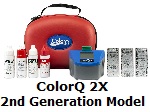 f your pool is being maintained
with a chlorine feeder, chlorination only occurs while the
filter is operating. By splitting the time, the pool is not
more than 6 hours away from a chlorine addition. In your
case, the algae is developing because you are probably
failing to maintain a sanitizer level adequate to carry the
load throughout the day. You need to focus on the free
chlorine level and keep it at 1-3 PPM, for as much of the
time as possible. Using the right tester can help. The
ColorQ 2X All-Digital, Water Analyzer
will provide the right information with reliability and
convenience. Check the pH and stabilizer level to assure
optimum chlorine performance. Your
salt chlorine
generator can maintain proper free chlorine levels much
better than a chlorine feeder or manual additions of
chlorine products. Keeping your filter cartridge clean will
improve water flow and circulation. In turn, this makes
algae growth less likely and improves the water quality.
Usually cartridge filters are cleaned weekly, especially in
the peak of the season. You can use The
BLASTER automatic filter cartridge cleaner and save yourself
the weekly chore. It requires no installation and is worth
looking into. I hope that I provided some help with your
question.
f your pool is being maintained
with a chlorine feeder, chlorination only occurs while the
filter is operating. By splitting the time, the pool is not
more than 6 hours away from a chlorine addition. In your
case, the algae is developing because you are probably
failing to maintain a sanitizer level adequate to carry the
load throughout the day. You need to focus on the free
chlorine level and keep it at 1-3 PPM, for as much of the
time as possible. Using the right tester can help. The
ColorQ 2X All-Digital, Water Analyzer
will provide the right information with reliability and
convenience. Check the pH and stabilizer level to assure
optimum chlorine performance. Your
salt chlorine
generator can maintain proper free chlorine levels much
better than a chlorine feeder or manual additions of
chlorine products. Keeping your filter cartridge clean will
improve water flow and circulation. In turn, this makes
algae growth less likely and improves the water quality.
Usually cartridge filters are cleaned weekly, especially in
the peak of the season. You can use The
BLASTER automatic filter cartridge cleaner and save yourself
the weekly chore. It requires no installation and is worth
looking into. I hope that I provided some help with your
question.
Sincerely. Alan Schuster, 5/10/2020
►
Diatomaceous Earth Filter And Floc?
Alan, is there any problem using floc with DE filters? I
thought that I heard not to do this somewhere. Thanks.
Frank K., 6/17/2008
I've never been a big fan of floc. However, it does work. It
clears up water by creating a gelatinous precipitate that,
as it falls to the
bottom, attracts suspended matter and takes it to the
bottom. The end result is that you have a bigger amount of
sediment to remove, by vacuuming. The problem with DE pool
filters is that if you get too much of the gelatinous
sediment into the filter, it can clog the filter. Inasmuch
as it is impossible to vacuum all of the gelatinous material
to waste, without leaving a small quantity behind, you may
end up with a clogged filtration system. DE pool filters are
very efficient and are usually able to deal with suspended
matter, in the course of normal operation. I hope that I have been of assistance.
Sincerely. Alan Schuster, 6/17/2008
► Which
Filter To Choose?
I am in the process of replacing a
tired old sand filter. My pool is approx. 20000 gallons and
I see a lot of ads for cartridge filters. How do they
compare to sand filters for effectiveness, etc? They don't
seem to be as popular in Canada as down south. Thanks for
any info that you may have.
Ed L., Osoyoos, B.C. Canada, 4/2/2008
I am not an expert on pool filters. However, based upon the
questions that have been submitted to me, over many years, I
would conclude that you are more apt to be satisfied with
the water quality, if you elect to utilize a quality
cartridge filter or a modern sand filter, using
a zeolite sand filter replacement media in place of
sand. Zeolites are modestly priced, longer lasting and can
produce results rivaling a D.E. filter. Speak with some of
the local builders. Good luck with your decision.
Sincerely. Alan Schuster, 4/2/2008
► Sudden
Filter Problem?
We have an in-ground, 30 mil, vinyl
pool with 17,400 gallons. This summer we had a sudden onset
of yellow-green silt looking stuff that goes right thru the
filter. It is an older style, (20 years) 102 square foot,
paper cartridge in a stainless steel bullet looking thing.
Up until now it has worked fine. When the problem came on we
suspected the cartridge so we replaced it. No help. The
filter base had a small internal crack so we replaced it
too. No help. I even fell for the "worn out filter pump"
story and replaced the old 3/4 horse with a new 1 HP pump.
It moves a lot of water but it didn't cure the problem.
Actually, the old motor and pump were making some noise.
Earlier in the summer the pool cleaner booster pump went bad
and we just plugged it off to continue using the filter
pump. I don't know if there is a connection or not. We have
used a variety of clarifiers to no avail. Last summer I put
some D.E. in it and it worked fine, but now everything just
goes thru the filter as if it wasn't there at all. We are at
the end of our rope. All I get from the locals is to replace
the entire filter with a newer, high dollar system. Is that
what I'm facing? I find it hard to believe that this is an
isolated problem. We have also totally replaced water twice
after other attempts turned sour. We have quizzed neighbors
with similar pools and they have no problems. What's up?
Rick P., Bakersfield, CA, 8/14/2009
From your description it sounds like you have "Yellow
Mustard Algae." While it is possible that you might have had
a filter problem, pool water filtration alone will not
remove yellow mustard algae. Changing the water will not
solve the problem. To control this type of algae, proper
chemical treatment is required. Please refer to the
archives,
Yellow-Mustard Algae Problems, for more complete information on
treatment. Good luck!
Sincerely. Alan Schuster, 8/14/2009
► Filter On
Or Off, When Adding Chemicals?
The filter must be on while adding
chemicals to the pool? Is this correct? I was doing the
opposite.
Luis S., 6/2/2005
The filter should always be operating while adding
chemicals, unless specifically directed otherwise.
Generally, you do not want chemicals to remain on the bottom
for prolonged periods. Always follow the manufacturer's
directions and never mix different chemicals together!
Sincerely. Alan Schuster, 6/3/2005
► Too Much
For The Strainer Basket?
A Southern Magnolia tree which is
flowering this time of year (May-June) overhangs the pool.
If the leaves weren't bad enough, tiny flower parts
(stamens, I believe) fall into the pool by the thousands,
get past the strainer basket, and clog the impeller. I've
had someone come out and clean the impeller twice now (very
expensive) but it clogs up again within days. Should I try
to get a basket with finer holes? Wrap the strainer basket
in a nylon stocking? Any help is appreciated. Thanks.
Brian D., 6/2/2004
Good idea!!! Although, it has already been invented. Local
pool dealers should have something that can be fitted into
your skimmers, to act just as you described. They are
sock-like, cover the strainer baskets and act as a
pre-filter. If only they were all this simple! Enjoy the
season.
Sincerely. Alan Schuster, 6/2/2004
►
D.E. Filter Or Sand/Zeolite Filter?
What is the best filter type for a
plaster finish gunite pool and attached spa with salt water
chlorination system? Does a sand filter with Zeolite really
filter as well as DE with less maintenance? Thank you.

Candice S., 10/31/2009
A sand filter filled with zeolite, in place of
ordinary sand, will provide filter efficiency similar to
that of a DE filter. Having a
salt chlorine generator will
even make it easier, as it will not be necessary to ever
regenerate the Zeolite. You'll get the water quality you
want, with the ease and convenience of a sand filter. I hope
that I have been helpful.
Sincerely. Alan Schuster, 11/1/2009
► A Cartridge
Filter Or A D.E. Filter?
I'd like your opinion on Cartridge
Filters. I had my above ground pool for 7 years and it came
with a D.E. filter. I never had a problem with it. Last
year, we had a built in pool installed and I was torn
between getting a D.E. or Cartridge filter. I decided to get
the cartridge filter because it's easier to maintain
(according to the sales rep). I noticed a few things with
this filter. It does not keep the water as clear as the D.E.
filter. Why? Is it because it's not able to filter out the
small particles like the D.E.? Is there anything that I can
do to keep the water clearer? Are these cartridge filters
OK?
Charlie W., Hemet, CA, 7/23/2010
Bull's Eye!!! You hit it right on the head! DE Filters can
remove smaller particles than cartridge filters. For people
who neglect their pool
maintenance, a DE filter can be a chore. For those who take
care of the pool, a DE filter provides better water quality. I hope that I have
been helpful. Enjoy the summer. I'm sure that you will come
to terms with your new filter.
Sincerely. Alan Schuster, 7/23/2010
► No Water In
Pump Basket?
Your website is extremely informative.
Recently bought a house with an outdoor inground concrete
pool. A few days ago I found that although the pool pump was
turned on, no water could be seen in the filter window and
also the needle in the pressure gauge does not move. I
checked the basket near the pump for leaves etc but there
were no debris. What do you think is the problem? Thank you.
Elizabeth, Birmingham, U.K., 1/23/2007
There is no water flow and that is why the gauge is reading
zero. The pump has lost its prime. The question is why?
Check all the seals. Shut off the pump. Clean out the
strainer baskets. Make sure the valve to the skimmers and
main drain, if present, are open. Use a garden hose and fill
the pump basket with water. Do it for a minute or until it
remains filled. Quickly close the lid to the pump strainer
and turn it on. Hopefully, the pump will re-prime and the
water will start circulating. If this does not work, you may
have a blockage. Remove the lines going in the pump and use
a shop vacuum to blow them out. If bubbling occurs the lines are clear. I hope that this information proves
helpful.
Sincerely. Alan Schuster, 1/23/2007
I carried out your instructions and
while re-circulating the water I discovered a leak under the
pump. An engineer came out and found a crack in one of
plastic pipes near the ball valve next to the pump. It's
sorted. Thank you so much for the invaluable advice. I
discovered your website last year whilst trying to learn
more about pool maintenance etc. It's good to read about
other people's experiences with their pools. Thanks and Have
A Nice Day!
Elizabeth, Birmingham United Kingdom, 1/24/2007
► Need To
Replace The D.E.?
Just had the pool resurfaced. A lot of
muriatic acid was used to take off white powder on the pool
walls. My question is after backwashing, do I have to refill
the filter with D.E.?
Jerry, Homosassa, FL, 5/12/2005
If you have the type of filter that allows for backwashing,
you must replace the DE, after every backwash. I hope that I
have been helpful.
Sincerely, Alan Schuster, 5/13/2005
► Sand In The
Pool?
I have an in-ground pool that is
approximately 15 years old. I have noticed these past 2
years that, after rinsing the filter, sand returns into the
bottom of the pool. While draining the pool, for the winter,
I placed the controls back into the filter position and,
after a short while, there were piles of sand on the bottom
near all 3 return lines. What is causing this? Is it because
the filter is too low on sand or is some thing broken?
Richard R., Granite Falls, MN, 6/17/2008
Something is definitely wrong with the filter. Sand should
not be getting into the pool, as you are describing.
Exactly, what is wrong is beyond the scope of my knowledge
(Too many filters and models).
I'm sure that a local dealer, that sells or services pool
filters will be able to help you to trouble-shoot the
problem. Good luck.
Sincerely. Alan Schuster, 6/17/2008
|
Visit The Website Stores . . . for
better informed shopping!!! |
|
 |
Shipping is FREE* . . . within
the Continental U.S.
A $9.99
handling charge will apply
to Continental U.S. Orders,
under $75.00. Orders
outside of the Continental
U.S. may require some
additional charge, based on
quantity and destination.
Most products can be
shipped World-Wide. International
and orders outside of
Continental U.S. - see
comments on the ordering
pages. |
|
 |

Major
Credit Cards and PayPal are accepted. |
|
▲
Return To Top Of Page
▲
Aqualab Systems, LLC does not
make any warranty or
representation, either expressed
or implied, regarding the
accuracy or completeness of the
information provided by this
website; nor does Aqualab
Systems., LLC. assume any
liability of any kind whatsoever
related to, or resulting from,
any use or reliance on this
information. The content of this
website should not be used, if
it is conflict with any
applicable federal, state or
local regulations or guidelines.
© Aqualab Systems, LLC. All
rights reserved





















